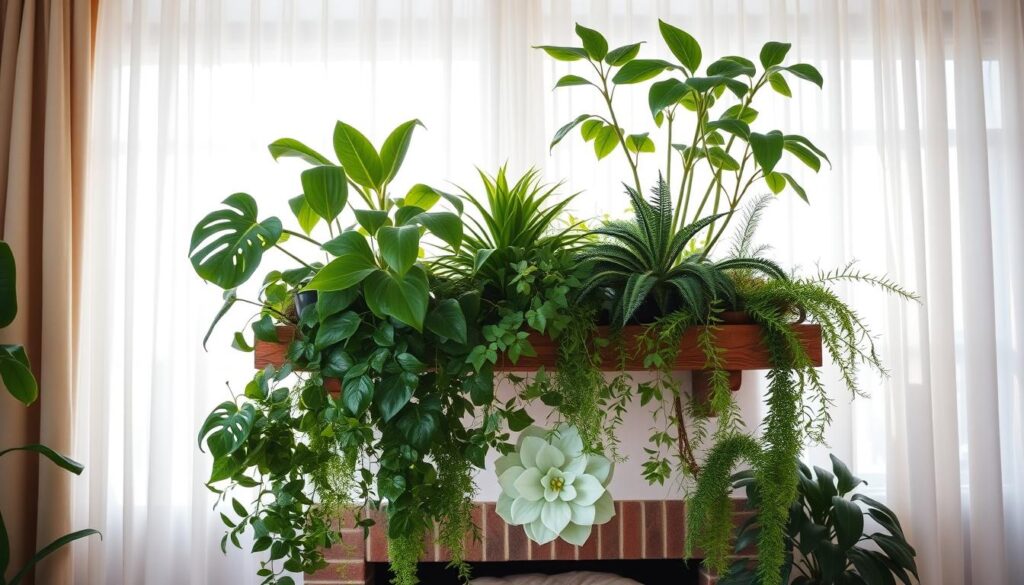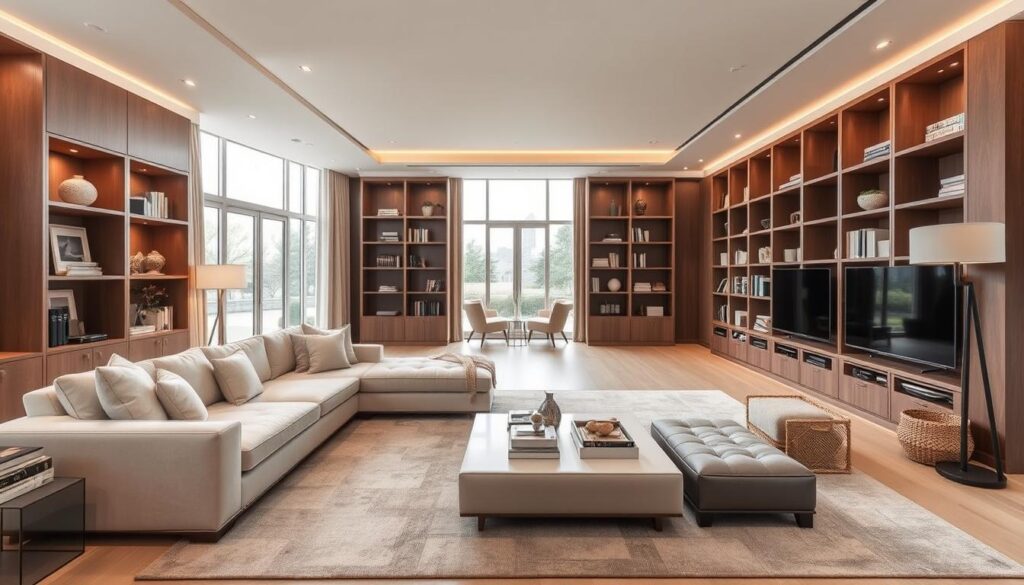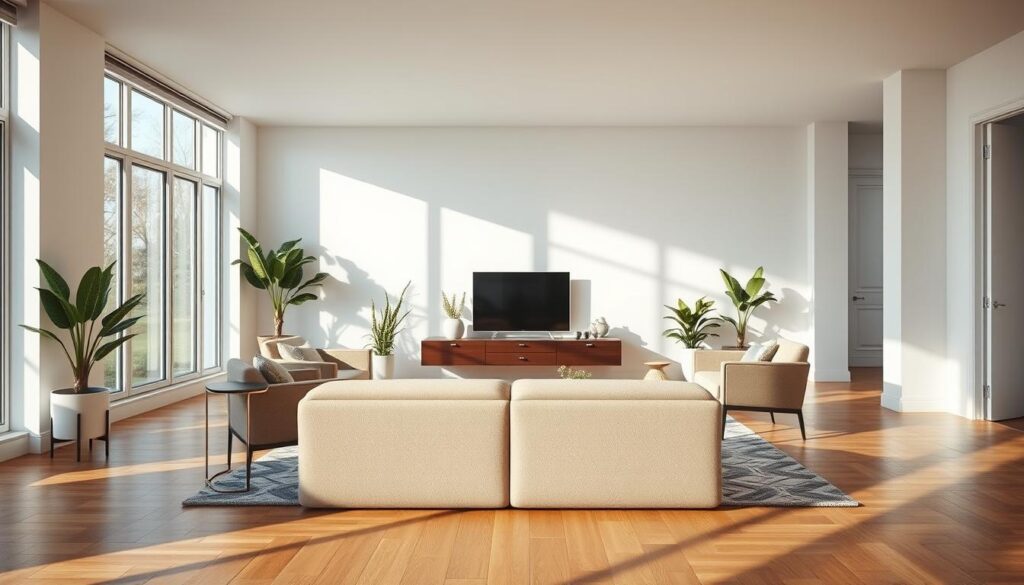A beautifully designed living space can be the heart of a home. It makes the home look better and work better. Did you know a well-designed living area can raise a property’s value by up to 15%?
We will share the top tips to make your living room stylish and welcoming. From modern design ideas to practical advice, we aim to inspire and guide you. Our goal is to help you create a beautiful and useful living area.
Key Takeaways
- Understand the importance of a well-designed living room
- Discover modern living room design ideas
- Learn how to enhance the aesthetic appeal and functionality
- Explore practical tips for transforming your living space
- Create a stylish and inviting living room with our expert advice
Understanding Living Room Essentials
To make a living room feel like home, we need to think about its main uses. It’s a place for relaxing, having fun, and hanging out with friends. This makes it a special part of our homes.
Key Functions of a Living Room
A living room is more than just a spot to watch TV. It’s a center for many activities. Relaxation is key, with comfy chairs and soothing decor. It’s also for entertainment, whether it’s having friends over or a quiet night alone. Knowing these roles helps us design a room that fits our needs.
| Function | Design Considerations |
|---|---|
| Relaxation | Comfortable seating, soft lighting, calming colors |
| Entertainment | TV placement, sound system, guest seating |
| Socialization | Conversation areas, coffee tables, decorative elements |
Space Planning: Creating Flow
Good space planning is key for a smooth living room. We need to think about the room’s layout and how people will move through it. Creating a clear pathway and setting up different areas makes the room more useful.
Choosing the Right Color Palette
Picking the right colors is important for living room design. The right colors can make the room feel better. For a minimalist home decor, choose neutral colors like whites, grays, and beiges. For something bolder, pick colors that show your personality, like blues and greens for calm or bright colors for energy.
- Neutral tones for a minimalist look
- Bold colors for a statement piece
- Think about the natural light and room orientation when choosing colors
By understanding the living room’s main uses, planning the space well, and picking the right colors, we can make a room that looks good and works well. Whether you want a minimalist home decor or something more, good design is always the goal.
Selecting Furniture for Comfort and Style
Creating a cozy and stylish living room starts with the right furniture. The furniture you choose sets the look and feel of your space. It also affects how comfortable it is.
It’s key to find a balance between comfort and style when furnishing your living room. Think about the size and type of furniture, the materials, and how they all work together. This creates a unified look.
Sofas and Sectionals: Size Matters
Size is crucial when picking out sofas and sectionals. A piece that’s too big can make the room feel cramped. A piece that’s too small might not offer enough seating.
Leave about 3 feet of space between furniture to make moving around easy. For smaller rooms, a compact sectional or a smaller sofa might be better.
| Room Size | Ideal Sofa Size | Recommended Sectional Size |
|---|---|---|
| Small (less than 150 sq. ft.) | 72 inches or less | Compact (3-seat) |
| Medium (150-250 sq. ft.) | 80-90 inches | Standard (4-seat) |
| Large (more than 250 sq. ft.) | 96 inches or more | Large (5-seat or more) |
Accent Chairs: Mixing Styles and Textures
Accent chairs can add a personal touch to your living room. Mixing different styles and textures makes the room more interesting.
Pair a modern chair with a vintage or traditional piece for contrast. Mixing textures like velvet, leather, and wood adds depth.
“The right accent chair can be a game-changer in a living room, adding a pop of color, texture, and style.”
Coffee Tables: Functional and Decorative
Coffee tables are both useful and decorative. Choose a table that matches your furniture in material, size, and style.
A table with storage keeps clutter away. A decorative table adds visual interest. For small rooms, consider a nesting table or one with a small footprint.
By picking furniture that balances comfort and style, you can make a living room that’s both beautiful and practical. Whether it’s a cozy spot or a big entertainment area, the right furniture makes it perfect.
Lighting: Setting the Mood
The right lighting can turn your living room into a cozy retreat. It’s not just about light; it’s about creating a mood that feels comfortable and relaxing.
Maximizing Windows for Natural Light
Natural light brightens a room effectively. Make sure your windows aren’t blocked by heavy curtains or furniture. Use sheer curtains or blinds to let sunlight in while keeping privacy.
As interior design experts say, “the key to a well-lit room is balancing natural and artificial light sources.”
Layered Lighting: Incorporating Fixtures
Layered lighting uses different light sources to create a warm ambiance. This includes overhead lights, table lamps, and floor lamps. It makes your living room feel cozy and functional, like a Scandinavian interior design living room.
For more cozy retreat ideas, check out Ouma Atelier’s cozy home interior design page.
Lighting experts say, “layered lighting is not just about adding more light; it’s about creating a visual hierarchy that guides the eye through the space.”
Dimmers: Adjusting Ambiance
Dimmers are great for adjusting your living room’s ambiance. They let you control the light intensity, creating a cozy mood for relaxing.
“Dimmers allow you to tailor the lighting to the activity, whether it’s reading, watching TV, or simply unwinding.”
This flexibility makes dimmers a valuable addition to any living room.
Incorporating Textiles for Warmth
Adding the right textiles can make your living room cozy. They not only warm up the space but also shape its look. This is key in making your home’s interior design pop.
Area Rugs: Defining Spaces
Area rugs are great for dividing spaces in open-concept homes. They bring warmth and comfort to your feet. When picking a rug, think about its size, material, and color to match your decor.
For affordable home decor ideas, choose rugs that are tough and simple to clean.
Throw Pillows: Adding Color and Comfort
Throw pillows are easy to use to add color, texture, and comfort. They’re also simple to change out for a new look. Mix patterns, textures, and sizes for a nice look.
This is a chance to use affordable home decor ideas. Pick pillow covers that are easy to make or swap out.
Curtains and Drapes: Privacy and Style
Curtains and drapes offer privacy and style. They control light and add elegance. For a unified look, pick curtains that match your colors and furniture.
Think about using thermal or blackout curtains for better function and energy saving.
By adding textiles like area rugs, throw pillows, and curtains, you can make your living room warmer and more inviting. These elements help create a space that’s both cozy and stylish, showing off your personal taste and needs.
Personalizing Your Space with Artwork
Adding artwork to your living room makes it truly yours. It brings depth and character, turning a house into a home. This personal touch is key to a unique space.
Choosing the Right Pieces for Impact
Choosing the right artwork is crucial. Think about the room’s colors, furniture, and overall feel. For a modern living room design ideas, pick pieces that are sleek and simple.
Consider the size of the artwork in relation to the room. A big piece can be a centerpiece. Smaller ones can be grouped for a gallery wall.
Gallery Walls: Tips for Arrangement
Gallery walls showcase a collection of art or photos. Start by picking pieces that match in theme or color. Lay them out on the floor before hanging to get the layout right.
- Start with a central piece and build around it.
- Vary the sizes and orientations of the frames.
- Leave consistent spacing between frames, about 2-3 inches.
Using Local Artists to Support Community
Buying local art adds a personal touch and supports the community. Look for local galleries, art fairs, or online platforms for local artists.
| Benefits of Buying Local Art | How to Find Local Artists |
|---|---|
| Unique pieces that reflect local culture | Visit local art galleries and exhibitions |
| Direct support to local artists | Attend local art fairs and festivals |
| Potential for commissioning custom work | Search online for local art platforms and social media groups |
By choosing artwork that speaks to you, your living room becomes both stunning and meaningful. Whether it’s for a luxury living room design or a more eclectic look, it’s all about personal expression.
Bringing Nature Indoors
Bringing the outdoors in is a simple yet effective way to create a cozy home interior design. It feels both natural and inviting. By incorporating elements of nature, we can enhance the aesthetic and ambiance of our living rooms.
Houseplants: Benefits and Best Plants
Houseplants are not only a great way to purify the air. They also add a touch of natural beauty to our living spaces. Some of the best plants for indoor spaces include snake plants, spider plants, and peace lilies. These plants are known for their low maintenance and air-purifying qualities.
Benefits of Houseplants:
- Improved air quality
- Aesthetic appeal
- Stress reduction
- Low maintenance

Indoor Gardens: Creating a Lush Look
Creating an indoor garden can be as simple or as elaborate as you like. From a small herb garden on a windowsill to a lush, multi-tiered indoor garden, the options are endless. Incorporating a variety of plants and using creative planters can add depth and visual interest to your space.
Tips for Creating an Indoor Garden:
- Choose plants that thrive in indoor conditions
- Use a variety of planters and containers
- Consider vertical gardening options
- Don’t forget to incorporate decorative elements like rocks or moss
Natural Materials: Incorporating Wood and Stone
Incorporating natural materials like wood and stone into your living room design can add warmth and texture. From wooden furniture to stone fireplaces, these elements can create a cozy and inviting atmosphere.
| Material | Uses | Benefits |
|---|---|---|
| Wood | Furniture, flooring, wall paneling | Warmth, durability, natural beauty |
| Stone | Fireplaces, countertops, decorative accents | Elegance, durability, unique patterns |
By incorporating these natural elements, we can create a living room that feels connected to the outdoors. This promotes a sense of calm and well-being.
Creating Zones in an Open Concept Living Room
Open-concept living rooms are great for being flexible, but setting up different areas can be tricky. To make a space that works well and looks good, we need to define zones. We can do this with smart furniture placement, using area rugs, and setting up specific activities for each area.
Defining Areas with Furniture Placement
Where we put our furniture is key to setting up zones in an open-concept living room. By arranging furniture to create separate areas, we can feel like we have different rooms without walls. For example, a sofa can help define a seating area by facing a dining space.
When picking furniture for small living rooms, choose pieces that do more than one thing. A storage ottoman can be a coffee table and a place to store things, keeping the room tidy.
Using Rugs to Separate Spaces
Area rugs are also great for dividing up an open-concept living room. By putting rugs under certain furniture, we can make the space feel like it has different areas. For instance, a rug under a seating group can mark the living area, while a rug under the dining table can define the dining space.
Using Scandinavian interior design living room ideas, like light-colored rugs and simple decor, can make the space feel open and connected.
Designating Activities: Living, Reading, & More
It’s important to assign activities to specific areas in an open-concept living room. By setting up different zones for things like reading or working, we can make sure the space meets our needs.
Here’s an example of how we can set up different zones:
| Zone | Furniture | Activity |
|---|---|---|
| Living Area | Sofa, Coffee Table | Relaxing, Watching TV |
| Reading Nook | Armchair, Floor Lamp | Reading |
| Dining Area | Dining Table, Chairs | Eating |
By carefully designing our open-concept living room into different zones, we can create a space that is both useful and beautiful. It meets our needs while keeping a unified look.
Storage Solutions for a Clutter-Free Living Room
Keeping your living room tidy is key to a peaceful space. A clean room looks better and feels more welcoming. We’ll look at ways to keep your living room clutter-free, making it a cozy retreat.
Built-In Shelving: Custom Solutions
Built-in shelves are great for storing things while keeping your room looking neat. They fit any room perfectly, making them perfect for luxury living room design. For tips on a clutter-free home, check out Houzz.

Multi-Functional Furniture: When Space is Tight
In small rooms, multi-functional furniture is a lifesaver. Items like storage ottomans or coffee tables with hidden storage can cut down on mess. These affordable home decor ideas save space and make your room more useful. For tiny homes, multi-functional furniture is a must, as Ouma Atelier explains.
Decorative Baskets and Boxes: Styled Storage
Decorative baskets and boxes are a stylish way to store things. They can hold blankets, magazines, and toys, keeping your room neat. These solutions add to your room’s look while keeping it organized. They help balance style and function in your living room.
With these storage tips, you can have a tidy living room that’s both stylish and practical. Whether you want a luxury living room design or affordable home decor ideas, good storage is essential. It makes your space feel cozy and inviting.
Seasonal Decor: Keeping It Fresh
Seasonal decor updates can make your living room feel new and exciting all year. By adding elements that match the season, your space stays fresh and fun. This way, you can show off your style and make your living room change with the seasons.
Holiday Themes: Quick Updates
Updating your living room for holidays is easy. For winter, add Christmas trees, menorahs, or Hanukkah decorations. In spring, go for Easter or Passover decor. Simple changes like throw pillows, wreaths, or holiday art can make a big difference.
Seasonal Color Swaps: Fabrics and Accessories
Changing fabrics and accessories by season is another smart move. In fall, use warm colors like orange and red. In spring, opt for light colors like pastel pink and mint green. These changes can totally refresh your living room, fitting with modern living room design ideas that love change.
Rotating Artwork: Keeping Interest Alive
Changing your artwork seasonally keeps your living room interesting. Display pieces that match the season or your interests. For example, summer might mean beach art, while winter is for snow scenes. This keeps your decor lively and lets you try out different color schemes for living room looks.
With these seasonal decor tips, your living room will stay lively and welcoming all year. Whether it’s for a holiday, color swap, or artwork change, the most important thing is to have fun and be creative.
Sustainable Practices in Home Design
As we wrap up our guide to home interior design living room, let’s think about how our choices affect the environment. Using sustainable practices is good for the planet and makes our homes look and work better.
Choosing Eco-Friendly Materials
Starting with eco-friendly materials is a smart move for affordable home decor. Look for items that are recycled, recyclable, or come from sustainable sources. For example, furniture made from reclaimed wood or bamboo flooring can make your living room special and help the environment.
Energy-Efficient Lighting Options
Choosing energy-efficient lighting is key to sustainable home design. LED bulbs use much less energy than old bulbs. They can light up your space in many ways, making it cozy and welcoming.
Giving Old Furniture a New Life
Turning old furniture into something new is a creative way to cut down on waste. With a bit of creativity, you can make an old piece into something stylish and useful. It shows how you can decorate your home affordably and sustainably.


